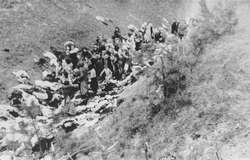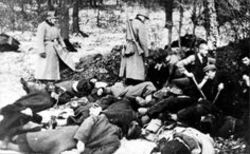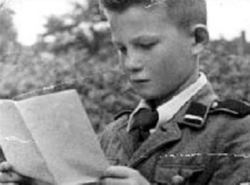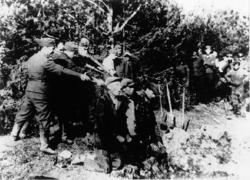Einsatzgruppen Death Squads
The Murder Machine
The Murder Machine
The Third Reich was built on violence. It governed with violence, dominated Europe with violence and provoked a violent response that finally destroyed it. (Masters of Death. The SS Einsatzgruppen and the Invention of the Holocaust (2002) Richard Rhodes p.19) It took violence to end violence but not before the Einsatzgruppen had murdered over one million men, women and children for no reason other than their religious beliefs, or that they were simply deemed a threat to German security and therefore unworthy of life. Millions more would perish within the Nazi death factories within Poland.
The Einsatzgruppen:
The Einsatzgruppe (special groups) were a mobile task force which followed the Wehrmacht (Germany's armed forces) into occupied countries. Their primary roles were to identify any and all potential enemies, and liquidate them. The Einsatzgruppe were attached to Amt (office) IV of the Reichssicherheitshaupttamt (RSHA) better known as the Reich Central Security Office. The Einsatzgruppe worked closely with the German Security police. And it's been estimated that some 2 million died at their hands.
Einsatzgruppen ‘Akions’ [Operations] were initiated through 'Operation Tannenberg', which was the codename for rounding up the Polish intelligentsia after the German military machine rolled into Poland. Prior to the invasion, the SS had been compiling a list of all potential targets who were to be arrested and liquidated immediately. This way, the Poles wouldn't be able to organise themselves into a coherent resistance movement against German rule. To achieve this aim, Reinhardt Heydrich had established four (which would eventually swell to seven as the war progressed) Einsatzgruppen, each Einsatzgruppe would be comprised of between two and four Einsatzkommando (special commandos), which would have approximately 100-150 service personnel. Each Einsatzgruppe would be required to keep detailed records of their actions and supply accurate reports to Berlin on a regular basis. The Einsatzkommando were extremely mobile as they combed their respective areas for victims, and which would eventually be used to liquidate the Jews, Communists and partisans (or alleged partisans).
The Einsatzgruppe (special groups) were a mobile task force which followed the Wehrmacht (Germany's armed forces) into occupied countries. Their primary roles were to identify any and all potential enemies, and liquidate them. The Einsatzgruppe were attached to Amt (office) IV of the Reichssicherheitshaupttamt (RSHA) better known as the Reich Central Security Office. The Einsatzgruppe worked closely with the German Security police. With approximately 3,000 members they managed to murder between 1 - 2 million men, women and children, in the most horrendous ways.
Smaller detachments were called Einsatzkommandos and Sonderkommandos which were mobile units who combed their respective areas of responsibility for Jews, Communists, partisans, the intelligentsia and saboteurs. Whoever fell into their hands were subsequently executed.
Einsatz breakdowns and Areas of Responsibility:
Einsatzgruppen A
Commanded by SS Colonel Dr Walter Stahlecker.
Attached to: Army Group North.
Operated within the Baltic state such as Lithuania, Latvia and Estonia
Sub Units Consisted of:
Sonderkommando 1a (Martin Sandberger)
Sonderkommando 1b
Einsatzkommando 2
Einsatzkommando 3 (Karl Jäger)
Einsatzgruppen B
Commanded by SS-General Arthur Nebe,
Attached to: Army Group Centre.
Operated within the areas of Byelorussia and central Russia itself.
Sub Units consisted of:
Sonderkommando 7a
Sonderkommando 7b
Sonderkommando 7c
Einsatzkommando 8 (Arthur Nebe)
Einsatzkommando 9 (Alfred Filbert)
Vorkommando Moskau
Einsatzgruppen C
Commanded by SS-Brigadier General Dr Otto Rasch
Attached to: Army Group South
Operated within northern and central Ukraine.
Sub Units consisted of:
Einsatzkommando 4a
Einsatzkommando 4b
Einsatzkommando 5
Einsatzkommando 6
Einsatzgruppen D
Commanded by SS-Colonel Professor Otto Ohlendorf
Attached to: Army Group South.
Operated within southern Ukraine including the Crimean Peninsula.
Sub Units consisted of:
Einsatzkommando 10a (SS-Obersturmbannführer Zeezen)
Einsatzkommando 10b
Einsatzkommando 11a
Einsatzkommando 11b
Einsatzkommando 12 (Emil Haussmann)
Each of the Einsatzgruppen and their respective task forces relied on the Wehrmacht for its logistics (food, fuel, and quarters). It would also call on the assistance of the Wehrmacht from time to time, and the Wehrmacht would sometimes turn to the Einsatzgruppen to help reinforce sectors that required extra security.
Each Einsatzgruppe was expected to send reports which included intelligence matters as well as numbers executed to Berlin regularly.
Heinrich Himmler also placed senior officers within each of the army groups. These officers were Higher SS Police Leaders (HSSPF). Hans Prutzmann was assigned to Army Group North (later replaced by HSSPF Friedrich-Wilhelm Krüger), Erich von dem Bach-Zelewski to Army Group Centre, and Friedrich Jeckeln to Army Group South. They would report directly back to Himmler and Heydrich and have crucial control over their respective Einsatzgruppens.
On 25 July 1941, Heinrich Himmler, established auxiliary forces known as the 'Schutzmannschaften' within the Baltic regions under German control to assist in carrying out security measures and to assist the Einsatzgruppen in the murderous task of murdering those deemed as national threats, which included the Jewish populations.
Other Groups involved in the Slaughter:
Sipo-SD
Reserve Police Battalion 101
Police Battalion 307
Police Battalion 30
SS Cavalry Brigade
1st SS Infantry Brigade
11th Lithuanian Police Battalion
A Survivors Report:
A victim and survivor of a Ukrainian massacre testified that "As soon as the small children got down from the trucks, the police took them from their parents and broke their spinal column against their knees. Small babies were thrown in the air and shot at or caught on bayonets and then flung into the trenches." (David Cesarani. Final Solution. The Fate of the Jews 1933-49. p424-425).
Major General Walter Bruns’s Description of the Execution of Jews outside Riga on 01 December 1941, Surreptitiously Taped Conversation (25 April 1945)
" I'll tell you something: some of the details may have been correct, but it was remarkable that the firing squad detailed that morning - six men with tommy-guns were posted at each pit; the pits were 24 m in length and 3 m in breadth - they had to lie down like sardines in a tin, with their heads in the centre. Above them were six men with tommy-guns who gave them the coup de grace. When I arrived, those pits were so full that the living had to lie down on top of the dead; then they were shot and, in order to save room, they had to lie down neatly in layers. Before this, however, they were stripped of everything at one of the stations - here at the edge of the wood were the three pits they used that Sunday and here they stood in a queue 1½ km long which approached step by step - a queuing up for death. As they drew nearer, they saw what was going on. About here they had to hand over their jewellery and suitcases. All good stuff was put into the suitcases and the remainder thrown on a heap. This was to serve as clothing for our suffering population - and then, a little further on they had to undress and, 500 m in front of the wood, strip completely; they were only permitted to keep on a chemise or knickers. They were all women and small two-year-old children. Then all those cynical remarks. If only I had seen those tommy-gunners, who were relieved every hour because of over-exertion, carry out their task with distaste, but no, nasty remarks like: "Here comes a Jewish beauty." I can still see it all in my memory: a pretty woman in a flame-coloured chemise. Talk about keeping the race pure: at RIGA they first slept with them and then shot them to prevent them from talking. Then I sent two officers out there, one of whom is still alive, because I wanted eye-witnesses. I didn't tell them what was going on, but said: "Go out to the forest of SKIOTAWA(?), see what's up there and send me a report." I added a memorandum to their report and took it to JAKOBS myself. He said: "I have already two complaints sent me by Engineer 'Battalione' from the UKRAINE." There they shot them on the brink of large crevices and let them fall down into them; they nearly had an epidemic of plague, at any rate a pestilential smell. They thought they could break off the edges with picks, thus burying them. That loss there was so hard that two Engineer 'Bataillone' (sic) were required to dynamite the edges; those 'Bataillone' complained. JAKOBS had received that complaint. He said: "We didn't quite know how to tell the FÜHRER. We'd better do it through CANARIS." CANARIS had the unsavoury task of waiting for the favourable moment to give the FÜHRER certain gentle hints. A fortnight later I visited the 'Oberbürgermeister' or whatever he was called then, concerning some other business. ALTENMEYER(?) triumphantly showed me: "Here is an order, just issued, prohibiting mass-shootings on that scale from taking place in future. They are to be carried out more discreetly." From warnings given me recently I knew that I was receiving still more attention from spies."
Did you know:
That the youngest member of an Einsatzgruppen was a five-year-old Latvian boy, and what's even more remarkable is that this young boy was Jewish who had fled into a nearby wood when the killing squads entered his village and rounded up the Jews to be slaughtered and dumped in a hole in the ground. The child's parents had gone into that hole. His story of survival is astonishing and brutal. After his escape he sought out help from an old woman living in a shack near the wood, after being fed, her son arrived home, but instead of helping the child he bundled him up and handed him over to a Latvian SS-auxiliary squad for financial gain [the Nazis paid a bounty for every Jew handed in]. After being placed against a wall to be shot alongside other Jews, this remarkable young boy left the line and walked over to the sergeant in charge of the shooting party and begged for something to eat. The sergeant, surprisingly, took the child into a nearby hut where he gave him a little bread, and got him to drop his trousers. After a quick inspection, the sergeant seemed unsure of what to do next. Suddenly he warned the child to ensure that no-one else ever saw what he just saw, and to enforce the message, he held the child up to the window so that he could see the danger of letting people know [those Jews he had stood with at the wall were now all dead on the ground]. The Sergeant had, for whatever reason, decided to save this child. And this young boy would soon be adopted as the unit's 'Mascot' and was fitted out in a Latvian SS uniform and accompanied them on their mission to rid Latvia of Jews. Later, he would appear in a Nazi propaganda film and his image and story printed within Nazi newspapers. The Sergeant kept the child's Jewish identity secret which saved his life. (Note: Questions arose concerning Kurzem's Jewish background though it was always accepted that he was used as a Mascot of the Latvian SS murder squad. However, DNA has shown that did indeed have a Jewish ancestry. see: https://www.forensicmag.com/570262-Genetic-Genealogy-Confirms-Story-of-Alex-Kurzem-the-Nazi-s-Little-Jewish-Mascot/).
This remarkable story can be found in Mark Kurzem's fantastic book 'The Mascot, The extraordinary story of a young Jewish boy and an SS extermination squad' (2007).
Above: Alex Kurzem in the uniform of the Latvian SS Death Squad.
Einsatz Group H - Slovakia
Einsatzgruppe H was created in August 1944 with the aim of removing what was left of the Jewish population in Slovakia and to take part in anti-partisan activities. SS-Obersturmbannführer Josef Witiska (later promoted to SS-Standartenführer) was given control of this unit who collaborated with the Hlinka Guard Emergency Divisions as well as local Volksdeutsche paramilitary units.
It consisted of two Kommandos: Einsatzkommandos 13 and 14.
Einsatzkommando 13 was originally led by Otto Kosloski and then Karl Schmidt
Einsatzkommando 14 was controlled by Georg Heuser.
Each Kommando was further broken down into smaller units. These units were: Sonderkommando 7a, zb-V Kommandos 15, 27 and 29.
After the war and whilst in American hands, Josef Witiska committed suicide and Otto Kosloski was executed by the Czechoslovakian authorities in 1947. Other members of the Einsatzgruppe were convicted within other national courts, but like the Einsatzgruppen as a whole, most of their personnel never stood trial.



